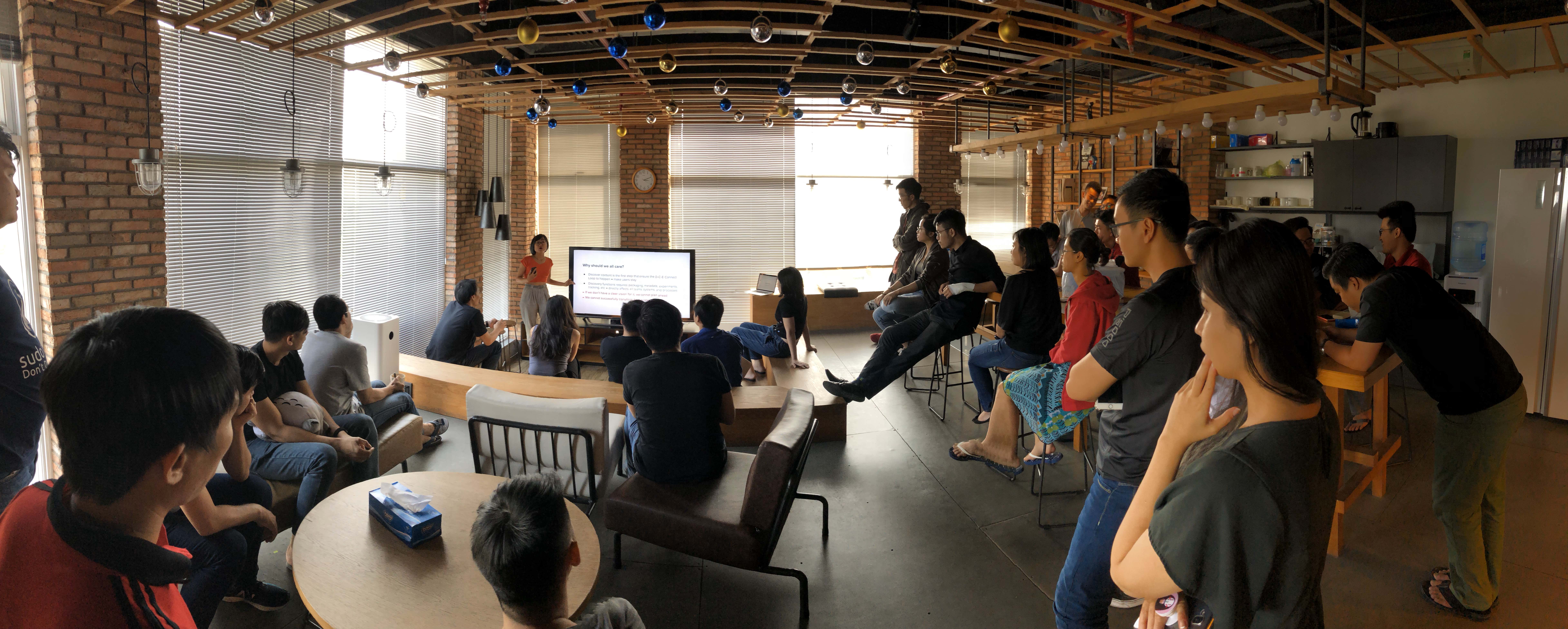News: Unmuted founder Max van den Ingh on success beyond the metrics
“You have to understand that working at a startup often feels like you’re standing on the edge of a cliff. And that’s also the moment you’re at your most creative.”
There is no authoritative playbook for marketing these days. Every company must find its own voice, and as it grows and evolves, its marketing needs to evolve as well.
Relying on proven tactics and measurable metrics isn’t enough — today, the most effective marketers constantly study and learn from innovative approaches while exploring new avenues.
This is where Unmuted comes in. A growth marketing agency based in Amsterdam, this company focuses on LinkedIn marketing, content marketing, marketing automation and email marketing. Before starting Unmuted, Max van den Ingh was head of growth and product at MisterGreen, an electric vehicle leasing company, and he also served as head of growth marketing at ShopPop, a chat-based marketing platform.
Van den Ingh, who also serves as a guest lecturer at Nyenrode Business University, was recommended to TechCrunch through the TechCrunch Experts project. We’re currently on the lookout for top-tier growth marketers that you can recommend to other startups. If you know of one, let us know by filling out this quick survey.
Van den Ingh spoke with us about his “modern” approach to marketing, setting realistic goals, how startups had to shift during the pandemic and more.
Editor’s note: This interview has been edited for length and clarity.
You call Unmuted a “modern” growth marketing agency. What do you do that makes your approach to marketing modern?
The way we help our clients is fundamentally different from how most traditional marketing agencies operate. At Unmuted, our clients don’t come to us to have their ideas executed; they come to us for our process. In a way, we’ve productized a growth marketing process that generates ideas for our clients. They find immense value in that process.
Depending on the customer’s team size and resources, we either guide them during execution or execute autonomously and report back. This process-based service model is, in our opinion, the only way to grow a business in a sustainable way.
“The way we help our clients is fundamentally different from how most traditional marketing agencies operate. “
In a practical sense, this is what that process boils down to: We take all that we’ve learned from fast-growing companies and apply these principles to our clients’ businesses. Typically we focus on what we call “innovative companies” — whether that’s because they have a SaaS offering or they’re an innovator within a traditional industry doesn’t really matter. The process we’ve designed works for B2B startups, scaleups and SMBs. That last category can benefit greatly from the way we work.
Our role, then, is threefold: We come up with strategies that we carry out by experimenting with several proven marketing tactics based on our extensive in-house knowledge and experience. This relieves our clients’ marketing teams of potentially stifling tunnel vision.
Our growth program typically unfolds in three stages as well, which we call the Foundation, Acceleration and Transformation stages. In the Foundation stage, we set up the fundamentals based on an extensive audit of the client’s business, and start out with our initial experiments. In the Acceleration stage, we scale the experiments that have shown promising early results. Finally, in the Transformation stage, we teach our clients how to continue growing their business themselves. If necessary, we stick around in a consulting role.
Your work at MisterGreen helped it grow about 10x. How much can a client expect to grow when working with you? How do you help clients set realistic goals?
Setting goals is always a challenge, especially when it comes to marketing. Why should you aim for a certain number? Why not aim higher, or lower, for that matter? At Unmuted, when we start working with a new client, we perform a series of exercises together. This helps us get a clear picture of where the client is now and where they could be when we’ve optimized marketing.
Help TechCrunch find the best growth marketers for startups.
Provide a recommendation in this quick survey and we’ll share the results with everybody.
Next, instead of fixed numbers, like a specific amount of new customers in a given period, we focus on growth levers, like month-over-month growth in certain conversion or activation areas. Focusing on growth levers makes our work more actionable.
We then construct a framework as part of our growth program that also allows room for certain beliefs a company has. I feel this “belief system” is truly essential to any growth marketing strategy. If you don’t allow room for gut feeling activities and only focus on data-driven projects, you will end up only working on things you can measure. We believe that growth marketing will become more effective when you also invest time and effort in channels and spaces you can’t necessarily measure.
When people talk about your solution on WhatsApp or during podcast episodes, that’s amazing and will effectively influence revenue, but sometimes there’s just no way to track these activities.
Finally, we don’t make any guarantees when it comes to growth results. That’s not how it works. We’ll always aim to maximize results as part of the process. Diligent focus on continuous improvement and optimization comes first. Results will automatically follow afterward.
For instance, we recently helped a B2B SaaS platform increase demo requests by 350%. But this wasn’t the goal at all. The process we were following was focused on optimizing every aspect of the demo request journey, from acquiring visitors to optimizing the demo page and more. Every experiment we ran increased the demo request metric to some extent. After six months, you start seeing these compounded results.
You were also the head of growth at ShopPop. How did that experience shape the way you help your clients?
Working for a fast-growing B2B SaaS company with a self-serve product taught me quite a few things. For starters, the importance of getting a really clear understanding of what sustainable growth looks like. Especially in growth marketing, there are a lot of things you can do to gain short-term results. But this doesn’t necessarily help, because you might be acquiring customers that you lose in the long run.
For example, running aggressive advertising campaigns in the early stages to acquire new users in sectors that you know won’t benefit considerably from your product. This type of superficial growth will come back in the form of churn sooner rather than later, and simply isn’t sustainable.
At Unmuted, when we start working with a new client, we put a lot of time and effort into understanding their best type of customers, what their problems are, and why that’s the case. Only then do we start looking at how to solve those problems with our client’s products or services.
You’re a guest lecturer at Nyenrode Business University and do speaking engagements as well. What do you hope people take away from your talks?
When I stand in front of a crowd during a speaking engagement, I always share stories about times where I took a pragmatic approach and did things differently. Growth can come in different shapes and forms, and although it often seems simple, it’s never easy. People, and especially management, have to understand that growth takes time and that you need failures to learn.
You need to have conversations to be able to learn and iterate. It’s better to have the wrong type of conversations than not having any at all. Without feedback, there’s no way to grow. And while an eagerness to learn comes naturally to most marketers, this isn’t necessarily the case for your average business person. If I can inspire audiences with my approach to growing by learning, I think that’s a great takeaway.
How have you seen startups change during the pandemic?
A lot of startups have been forced to change their approaches during the pandemic. Some have adapted successfully, while others are now stuck. I experienced it personally when I was still working at ShopPop, where we were focused on the music industry when the pandemic hit.
Music industry clients weren’t buying, for obvious reasons, so we had to pivot somehow. We ended up moving into e-commerce, which was, and still is, booming.
As the pandemic continues, what trends are you seeing in growth marketing?
The biggest trend I’m currently seeing is in the role marketing departments play. These have never been as important as they are now. Digital marketers, especially, are often the ones that come up with new ideas as to how a company can grow online. Nobody will know how the COVID-19 pandemic will play out, but in the meantime, every company is trying to adapt and find new ways to connect with their customers in unique, meaningful ways.
Logically, we’re seeing a surge in demand for online events like webinars and virtual summits. But everybody is doing those. So where can you carve out your own thing that becomes recognizable for your brand? Discovering these new channels and approaches — I think that should be the role of marketing.
How have you seen the startup market develop while working in growth?
The development of the startup market has been most noticeable in how new standards are being set. For example, startups have always been characterized as fast movers, but remote working and the rise of highly collaborative tools have further increased the speed at which startups operate. The whole industry transformed from speedboats into rocket ships. Talent became much more accessible, and through that internal cultures became more diverse and more resilient.
You can always depend on startups adopting new ways of working early on. They need to differentiate in order to survive, and a novel approach can be the one thing that makes them stand out from the crowd.
You have to understand that working at a startup often feels like you’re standing on the edge of a cliff. And that’s also the moment you’re at your most creative. I think this is also how growth marketing as a whole came about. In competitive markets, people have to fight for their right to exist. Marketing is often a way to radically differentiate. When people become really good at that, set new standards and raise the bar, the market develops as a whole.
What do startups continue to get wrong?
It’s been said many times before, but even today, most startups don’t learn quickly and deeply enough. Founders often have an amazing idea and vision of how things will play out. But how much field experience does this person really have? Enough to be able to foresee the future?
Usually, for startups, short-term growth goes well — they get some initial traction from their network, but then the next phase kicks in. Especially when there’s an investment involved, putting more pressure on the commercial side of things, this next phase will mean encountering a lot of hurdles.
When a company doesn’t find a strong enough product-market fit and doesn’t apply what its learned early on, things will get extremely tough. In this phase, a lot of research and experimentation is necessary. If the founding team isn’t up for this and they put their heads in the sand, the startup will deteriorate quickly.
On the other side: What are startups doing better now than ever before?
The best thing a startup can do, and I’m seeing it happen more and more, is investing in community early on. When I was leading growth at MisterGreen, we created a community for the first thousand Tesla Model 3 owners in the Netherlands. Everyone wanted to be a part of this founding tribe, learn from each other, get insights and so on.
This group turned out to be our most effective marketing tool. Word-of-mouth went through the roof. We had all of these people talking about our community at birthday parties, in their office, you name it. This is a great example of investing in marketing you can’t really measure, but which you do strongly believe in.







